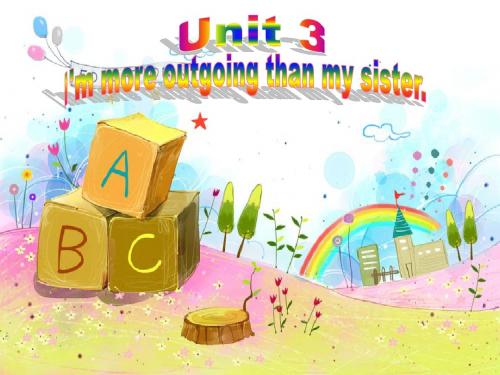2013年秋八年级上Unit3Section A-1
- 格式:ppt
- 大小:2.66 MB
- 文档页数:44





Unit 3 I’m more outgoing than my sister.Period 1 (Section A 1a-1c)Teaching Aims:1. Words: outgoing; better: loudly; quietly; hard-working; competition.Language objectives:That’s Tara, isn’t it?Sam has longer hair than Tom .Both Sam and Tom can play the drums, but Sam plays them better than Tom.Tara works as hard as Tina.2.Ability objectives:to talk about personal traits and compare people; to improve Ss ’speaking, listening and writing skills.to grasp the structure of comparatives,e.g. comparatives with –(i)er and more, both and as...as...;to grasp the structure: A+谓语+比较级(adj./adv.)+than+B,A+谓语+as+原级(adj./adv.)+as+B;to recycle vocabulary about description3. Emotional objectives: to find strengths of somebody else, to explore the beautyof the world.Important and difficult points:1. To talk about personal traits特点 ; to grasp how to compare people.2. To use target language: A+谓语+比较级(adj./adv.)+than+B, A+谓语+as+原级(adj./adv.)+as+B, comparatives with –(i)er and more.3. To improve Ss’listening, speaking and writing skills; to develop their communicative competence.Teaching Procedures:Step 1 Leading-in.1.To show some pictures to review-What does she look like?-She is thin/heavy/tall/short......2.Learn new words:outgoing,better loudly quietly which competition fantastichard-workingStep 2 1a look at the picture in 1a and make a list of the adjectives.Step 3 Presentation1. To show some pictures and make Ss compare them , show someexample sentences about comparative degree.2. To show some adjectives and adverbs with –(i) er, -r, more and some special words like better, more, worse, etc..Then ask Ss to discuss the common points of the words.Purpose: to lead in comparative degree; to make Ss summarize the change rules of comparative degree of adj.and adv.Step 4.1b Listening listen and write the number of the pairs.Listen again for the students to listen and fill in the chart.Check the answers with the classStep 5 Practice.1.Passing Game Ask Ss to make sentences with comparative degree one by one.2.Brain Storm Show some pictures and make them compare the two things in some way and guess the answers. Eg: Which means of transportation is safer, bus or plane?3.Guessing Game Ask a student to describe another student by using the comparative degree sentences. And others guess who is talking about.4.Additional materials: Show some proverbs about comparative degreeStep 6 ExerciseStep 7 To sum up.Step 8 Homework.。

Unit3 SectionA(1a-1c)优质课教案Type: Listening &SpeakingRun by: Zhang LuTeaching ObjectivesBy the end of this period, students will be able to:1. Knowledge objectives1) spell, read and recognize the following words (mainly about personal traits)and use them appropriately in speaking: outgoing, both, better, loudly, quietly; review and master the following words: tall, short, long, thin, heavy, hair, sing friendly.2) learn and grasp the following sentence structures: ①That’s Tara, isn’t it?No, i t isn’t. ②Tina is taller than Tara. ③And she also sings more loudly than Tara.2. Ability objectives1) learn and know the rules of comparatives of adjectives/adverbs and use them to talk about personal traits.2) role-play the conversation with correct and clear pronunciation.3. Emotional objectives1) have further understanding of their friends or families.2) find out the good traits of others.Important Points and Difficult Points:Important points:1. Target language above.2. Key words: outgoing, both, better, loudly, quietly3. The changing rules of comparative degree of adjectives and adverbs.Difficult points:1. Compare people by using comparatives and target language.2. The changing rules of comparative degree of adjectives and adverbs.Teaching Methods:Task-based Teaching Method, Situational Teaching Method, Interactive Teaching Method. Learning Methods:Preview(self-study), Cooperative learning, Drilling.Teaching Aids: multi-media, blackboard, text bookTeaching Steps:Step1: Warming-upBrainstorm:Q1: Who is your idol?Q2: What does she/he look like?Q3: What is she/he like?Step1: PresentationTask1: Guessing gameStudents will guess who are my idols according to my description and do more descriptions, so the key sentence structure “A+be动词+形容词比较级+than+B” will be introduced.More pairs of pictures will be presented and the opposite words will be learned: Tall-short long hair-short hair heavy-thin quietly-loudly At the same time, the comparative degree of these words will be presented: Tall-taller Yao Ming is taller than Mr. Bean. Short-shorter Mr. Bean is shorter than Yao Ming. Long-longer She has longer hair than Coffee. Heavy-heavier Alan is heavier than Ten. Thin-thinner Ten is thinner than Alan.Quietly-more quietly The first light music is more quietly than the second one.Loudly-more loudly The second light music is more loudly than the first one.Task2: Catch the ballIn order to practice the sentence structure, I will play a short video about my friends and let students practice their conversation with the following structures:My ... is big.A: My ... is friendly. My ... is handsome. My ... is bigger than...B: My ... is friendlier than ... My ... is more handsome than...Task3: Read and SpeakTall-taller short-shorter long-longer young-younger big-biggerthin-thinner fat-fatter heavy-heavier friendly-friendlier funny-funnier outgoing-more outgoing handsome-more handsome quietly-more quietly loudly-more loudlyStep3: PracticeTask4: Pre-listening。